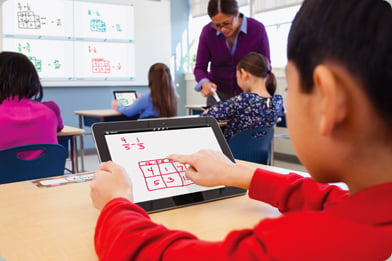 It used to be that textbooks, chalkboards, lectures, and note-taking were enough to provide an effective education. But these “old school” teaching tools and techniques are no longer up to the task. To be truly successful, students now need to have a deep comprehension of concepts and develop “21st Century” skills like critical thinking and collaboration.
It used to be that textbooks, chalkboards, lectures, and note-taking were enough to provide an effective education. But these “old school” teaching tools and techniques are no longer up to the task. To be truly successful, students now need to have a deep comprehension of concepts and develop “21st Century” skills like critical thinking and collaboration.
These new requirements have sent whirlwinds of change across K-12 education. The Common Core State Standards, which focus on developing in-depth conceptual understanding from the early grades onward, have been adopted by 46 states plus the District of Columbia. Race to the Top funding for innovation and reform has replaced No Child Left Behind accountability mandates. Are all these changes worth the effort? What will the final result look like? Despite the challenges that educators face, I think that both teachers and students are going to thrive in the new learning environment.
We are moving away from “teaching to the test” toward teaching for learning’s sake. Best teaching practices now consist of cross-curricular instruction and project-based, student-centric approaches that capture students’ interest and boost their ownership of the learning experience.
In our view, accessing this new educational landscape requires four key components: teacher-directed instruction, real-time formative assessment, collaborative learning, and adaptive instruction. In addition, teachers need tools that allow them to fit those components into lessons in easy and engaging ways.
Teacher-Directed Instruction
Student-centric environments make learners more engaged, more collaborative, and more motivated, but the teacher is essential for guiding instruction and keeping students on task. Interactive whiteboard and tablet technologies facilitate teacher-led instruction, while allowing students to interact with lessons and each other for a hands-on, in-depth learning experience.
Real-Time Formative Assessment
In order to differentiate instruction or direct small-group learning, teachers need to measure students’ understanding in real time. The sooner a teacher knows if and how a student needs help, the more options that teacher will have for adjusting instruction accordingly. Assessment tools like handsets, iPad applications, and programs with diagnostic and evaluation measures can be seamlessly integrated into lessons in order to provide data.
Collaborative Learning
Learning to collaborate helps to develop students’ critical thinking skills and build their knowledge across all curricular areas. These skills are essential for their future success and align to the new Common Core State Standards. Tools like interactive whiteboards, tablets, and iPad apps let students share their group work in real time. And group-instruction software programs explicitly teach collaboration skills.
Adaptive Instruction
Adaptive technology helps educators evaluate the strengths and weaknesses of each student, which ties into formative assessment and also aids small-group and differentiated instruction. The technology reveals how and why a particular student is struggling, so that the teacher can help that student master any concepts that are causing difficulty. In fact, adaptive instruction in reading programs is known to be one of the most effective ways to teach children to read.
Integrating Technology and the Four Keys for a Bold “New World”
You probably noticed that I included suggestions for interactive technologies with each component that I listed. Combining teacher-directed instruction, collaborative learning, real-time formative assessment, and adaptive instruction with interactive technology will allow educators to meet the needs of all learners at all levels. It won’t matter whether the student is an English-language learner, is on an IEP, or is at the “gifted” end of the spectrum in terms of ability. With the Internet and other technologies now available, educators and students can access education in an entirely new way.
Educational technology companies like Mimio have a responsibility to facilitate this new world of learning with the tools and services that educators and students now require. At our company, we’ve addressed the changes in the education field by focusing on technologies that can turn any classroom into an interactive and collaborative learning environment.
We’ve shared our vision of what education will look like. Comment below to share your vision with us and your fellow readers of Mimio Educator.





